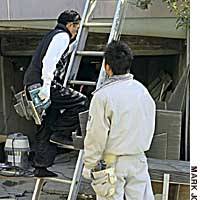Dear Alice,
On a trip to Japan last year, I passed some time watching a building in Toyohashi [Aichi Prefecture] being remodeled. A couple of the workmen were wearing these really baggy trousers. So, what the heck is the deal with those? I assume it must be some traditional Japanese thing, but they seem really impractical. What if the legs of the trousers got caught in heavy machinery or something?
Diane O., Redmond, Wash.
I've wondered about that too but none of my Japanese friends could even tell me what they're called. I once looked in an encyclopedia of traditional Japanese clothing but couldn't find them. So when I got your inquiry, I figured I would have to go to the source: find a worker with his trouser legs flapping in the breeze and fire off some questions. The problem is that where I come from nice girls don't loiter around construction sites.
Then I passed a store specializing in work clothes. The salesman knew just what I meant. "Oh, those bukabuka zubon (baggy trousers)," he said, and handed me a catalog from Toraichi Co. Ltd, the leading manufacturer in the field. We flipped through nearly a hundred pages with photos of macho guys wearing generously legged products in a huge range of styles and colors.
The salesman explained that the primary purchasers are tobi shokunin, people who work on high places such as scaffolding and skyscrapers. A little looseness around the knees makes it easier to climb and move but beyond that the give in the garb is largely a matter of fashion. And what the pants are called depends on the degree of bagginess.
Before I get into nomenclature, let me address your question about origin. Like you, I assumed the loose-leg look was something traditional. But according to a spokesperson at Toraichi, the cut is derived from Western knickerbockers, which were first worn in Japan as part of military uniforms. Prior to the introduction of Western clothing, he explained, Japanese carpenters wore slightly loose leggings called momohiki under a hip-length kimono-style top. But immediately after the war, when clothing was expensive and scarce, workers had to scramble for work wear. Many ended up outfitting themselves in military-surplus knicker-style trousers and the style caught on.
Modern work pants that are just a little roomy in the leg and gather at the ankle are called nikka zubon, from the English word "knickerbockers" plus the Japanese word for trousers. But I suspect the pants you spotted in Toyohashi had legs that puff out like those on a clown's costume. Those are called chocho zubon, written by repeating the kanji for "ultra." They come in various lengths including hachibu (eight-tenths), which taper in at midcalf and look pretty cool paired with jikatabi, the tight-fitting traditional boots still widely used by Japanese construction workers. This look is considered a tad rebellious and is not allowed at some construction companies.
I called up Toraichi to ask whether all that extra material might pose a safety hazard. No, just the opposite, a spokesperson asserted, explaining that many workers swear the wide legs work like a cat's whiskers by brushing against obstacles and alerting them to potential dangers. The company's Web site claims that although several workers fell to their deaths during the construction of the massive Seto Ohashi Bridge that links the islands of Shikoku and Honshu, none of them were wearing Toraichi trousers. "Word got around that you won't get hurt if you're in Toraichis," the site states, "and soon our trousers were legendary."
I'm skeptical about the whiskers theory but Toraichi definitely has a following, judging from the number of Web sites I found run by self-acclaimed toramani. That's a contraction of "Toraichi" and "maniacs" and refers to die-hard fans of Toraichi trousers. Many devotees admit they have never worked in construction -- they just find the look manly and cool. But not all fans are men. The Toraichi catalog includes female models and the spokesperson I talked to said Toraichis are popular with foreigners. My friend Pedro in Portugal confirmed that some trendy young people in major European cities wear baggy Japanese pants and jikatabi. "It's ninja fashion," he said.
Does this sound like just the ticket for "Casual Friday" at the office?" If anyone objects, you can show them Toraichi's English motto: "Fighting Spirit for Working."



















With your current subscription plan you can comment on stories. However, before writing your first comment, please create a display name in the Profile section of your subscriber account page.